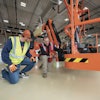In his article “It Takes a Team To Build a Business”, Ron Roberts — known as “The Contractor’s Business Coach” — covers one of the biggest challenges small contractors often face as they expand their business: the need to trust others to take on portions of the work.
Most individuals who start a construction firm are highly independent and entrepreneurial. Yet, as the business grows, there are increasing demands placed on their attention and they can be pulled in many directions. “Each task consumes more and more time,” says Roberts. “You only have so many hours available each day and week, so it’s simple math. You can’t do it all yourself.”
Consequently, an important part of business growth is putting together a team with the diverse skills and personalities needed to manage specific aspects of the business on your behalf. This means finding the right mix of people, and then trusting them to work with you to ensure long-term success.
While Roberts’ article focuses on internal teams, there are organizations and individuals outside of your company that can also have a substantial impact on its success.
Construction is an equipment-intensive business. The equipment fleet typically represents a contractor’s largest capital outlay and biggest operating cost. As such, equipment suppliers play a major role in the ability not only to complete current projects efficiently and profitably, but also to expand operations over time.
As equipment technology advances, contractors are being asked to place an ever greater degree of trust in manufacturers and dealers when it comes to expanding and managing their fleets. As a result, contractors are demanding a higher level of service in return.
Both OEMs and dealers are being required to step outside of their traditional roles as equipment sales and service providers to become true fleet management partners. Advances in equipment design and available features have complicated the purchase decision. Increasingly, contractors have expectations that dealer personnel will guide them through the spec’ing process to ensure acquired equipment meets their goals for performance and efficiency.
Contractors are also looking to equipment suppliers to maintain equipment in the field as part of service agreements, as well as assist in managing an ever-increasing volume of information being generated by their machines. Telematics technology can deliver a wealth of equipment operating data. Now, manufacturers are starting to put systems in place to compile data from even more sources, such as payload management systems, fluid analysis programs and grade control systems, into one platform. The potential volume of data generated is expansive, but its value is limited to how well it’s interpreted and put into action.
Interpreting the data in a way that enables you to draw meaningful conclusions about equipment productivity, performance and operating costs often calls for assistance from highly trained dealer and manufacturer representatives. It also requires contractors to take an “open book” approach and permit equipment suppliers to access information once held sacred.
Partnerships on this level dictate a high degree of trust and respect between all parties. In this issue, you’ll find real-world examples of such relationships in action in “Teamwork Triangle Cuts Equipment Costs”, and “Keeping Up with Cost-saving Technology”. While the approaches these companies used may not work in every circumstance, for the firms profiled, the leap of faith in a team approach has generated some pretty amazing results.



















